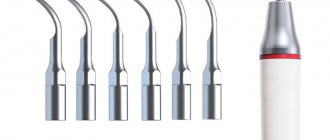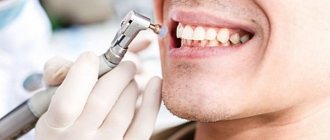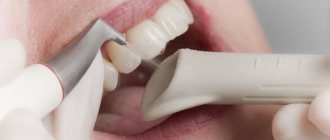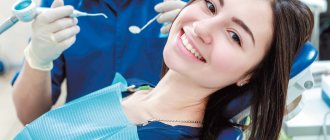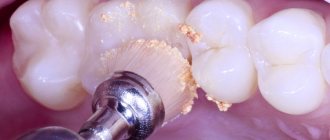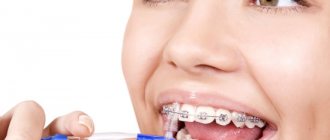A person’s health and the condition of their teeth are influenced by many different factors. Ignoring the rules of oral hygiene leads to dental diseases. True, sometimes even the most painstaking cleansing using premium quality pastes does not help get rid of all problems with oral cavity contamination.
It is common knowledge that you need to have dental cleanings twice a year. This is explained by the fact that even if all the rules of oral hygiene are observed, it is impossible to avoid the appearance of plaque. You can get rid of this phenomenon only in special ways - using ultrasound or using the Air Flow method.
Both of these methods have their merits. However, you need to figure out: what to choose to achieve the best effect? Teeth cleaning with Air Flow or ultrasound: which is better? We'll talk about this in the article.
Choosing a cleaning method and determining the best one
Dental clinics most often use ultrasonic or hardware cleaning (this is Air Flow). Both of these methods give good results, and their prices are in the same range, so it can be quite difficult to make a choice. But since these teeth cleaning methods are a medical procedure, it is necessary to study all aspects of these procedures. Perhaps one of the methods is not suitable due to contraindications or other factors.
Most people think that getting your teeth cleaned at the dentist is a stupid waste of money, but it's not. If plaque remains on the teeth for a long time, sooner or later it will turn into tartar. Due to dental plaque, gum damage can develop - periodontal disease. You can even lose your teeth if you don't worry about hygiene. That’s why you need to have professional cleaning done regularly, and your dentist will always help you decide on the method.
Important! Without consulting a specialist, a person is unlikely to be able to choose the method he needs.
The choice should be based on the individual characteristics of the patient, the health of the oral cavity and the body. After all, cleaning should never cause harm.
What is comprehensive teeth cleaning
Each of us follows basic hygiene rules, including brushing our teeth twice a day. With the help of this simple manipulation, we remove plaque accumulated during the day or night. But the problem is that the interdental spaces and hard-to-reach areas remain uncleaned or not cleaned well enough. As a result, plaque begins to accumulate in these places, and then mineralizes, that is, turns into tartar. It is impossible to remove it with a simple brush and paste. In this case, only professional help from a dentist will help.
The doctor, depending on the type of deposits, may suggest one or another method of cleansing.
The specificity of the instruments used determines the narrow focus of the impact. For example, ultrasonic waves can crush stone, and Air Flow technology can remove soft plaque. Human teeth simultaneously contain both already fossilized and still soft fractions, so for total cleansing it is necessary to use not just one method of professional hygiene, but several procedures in combination. In addition, the enamel layer, having lost its “shell” and has already begun to demineralize underneath, becomes very vulnerable for some time. Therefore, to restore it, it needs recharge, in particular fluorine. Based on the above, we can conclude that only a set of cleaning and protective measures will help your teeth be healthy and beautiful. Comprehensive cleaning includes the following procedures:
- ultrasonic treatment;
- cleansing using Air Flow technology;
- polishing the enamel layer;
- fluoridation.
When should you choose ultrasonic cleaning?
During this procedure, the dentist uses specialized equipment that allows for changing attachments. The size of the nozzle determines the effectiveness of cleaning and is selected based on the scale of dental plaque. Due to vibration effects, tartar is destroyed.
This procedure does not cause pain, so anesthesia is not necessary. This is a definite advantage of ultrasonic cleaning. If the patient still experiences discomfort, the doctor reduces the amplitude and frequency of vibrations. It is almost impossible to injure your gums or teeth during ultrasonic cleaning, which makes it safe.
Teeth cleaning is carried out with an ultrasonic scaler or hook, the tip of which reaches 30-40 thousand vibrations per second. Cleaning takes place quite carefully and carefully, relieving the patient of stone and plaque. Before cleaning, the doctor examines the patient’s oral cavity and determines the presence of contraindications.
Interesting! By the way, the procedure takes very little time.
Features of ultrasonic cleaning, stages of implementation.
- First, the tartar is removed.
- After removing the stone, the tooth is freed from plaque.
- After this, the teeth are covered with a special film that performs protective functions. This will prevent tartar from forming again.
At the first stage, stone is removed from the teeth using ultrasonic vibrations. To do this, the doctor uses a scaler, which very quickly relieves the patient of any type of stone.
At the second stage, the doctor removes plaque. An aerosol containing cleaning powder, air and water washes away plaque and other harmful deposits even from inaccessible places. After the procedure, tooth enamel becomes white and smooth again.
The third stage involves polishing the tooth surface using a special brush and paste, and polishing rubber bands. To improve the cleaning effect, teeth are coated with special products, allowing them to stay clean longer and protecting them from external influences.
Indications and contraindications
Although ultrasonic cleaning is recognized as safe, it has contraindications. So it is necessary to study who can undergo this procedure and who should refrain from it.
Ultrasonic cleaning is needed in the following cases:
- the patient notes an unpleasant odor from the mouth;
- in the presence of plaque and tartar;
- the gums are swollen and bleeding, there are deposits under them;
- when the color of the enamel changes.
All these factors indicate incipient problems with oral health. In fact, there are many more of them, but even with these signs it is better to go to the dentist so as not to worsen the problem. Ultrasound cleaning allows you to avoid many additional procedures, such as prosthetics.
However, there are contraindications for ultrasonic cleaning:
- inflammation in the body;
- viral or infectious diseases;
- chronic disease in the acute stage;
- the patient is a child or teenager;
- increased sensitivity.
Important! Almost all of these factors can be eliminated, so if you get rid of these problems, you can carry out ultrasonic cleaning.
How does ultrasonic teeth cleaning work?
The scaler tip produces ultrasonic waves that crush dental plaque into small particles. Then these particles are simply washed off with water. It is very important that ultrasound not only removes tartar on the visible surface of the enamel, but also copes with bacterial deposits in the interdental space and under the gum.
At the end of the session, the tooth surface is polished with nylon pads and abrasive paste.
Typically, no anesthesia is needed. But if you have sensitive enamel or inflamed gums, it is better to use a local anesthetic with lidocaine. The session takes 20-40 minutes depending on the amount and volume of dental plaque.
How does Air Flow work?
To clean teeth in this way, a sandblaster is used. Baking soda mixed with an abrasive substance is sprayed under pressure onto the surface of the tooth. Soda particles protect tooth enamel from injury, and tartar is removed due to a special composition. The procedure is carried out quite quickly, and the effect is amazing. It cannot definitely be called the best, since ultrasonic cleaning and cleaning with Air Flow differ in the method of implementation and active substances.
Why should a patient choose Air-Flow cleaning?
- this method is safe and contactless;
- no pain or discomfort;
- tooth enamel is not damaged;
- no vibrations or heating of the tooth;
- this method is an excellent prevention of oral diseases;
- Plaque can be removed even from hard-to-reach areas of the tooth;
- prevention of caries.
Video - Stages of teeth cleaning using the Air Flow method
Features of the Air Flow procedure
The high-pressure cleaning device sprays an air-water mixture in the desired direction with the addition of sodium bicarbonate (soda) particles. A convenient nozzle allows you to accurately direct a thin and powerful jet, while not only the teeth, but also the gums are treated.
Firstly, it ensures that subgingival pockets are cleaned of plaque and food residues, and secondly, it has a massage effect, especially useful for people prone to periodontitis and periodontal disease.
How to clean with braces?
The presence of braces almost always interferes with comprehensive teeth cleaning, so plaque and various harmful deposits appear around them. Air Flow will help you get rid of these problems. The composition sprayed onto the teeth will effectively rid their surface of dirt.
Important! Bacterial or pigment plaque is a signal that caries may soon develop. In advanced cases of caries, there may be complications such as periodontitis or pulpitis. Then a person risks losing a bad tooth.
Air Flow cleaning helps protect your teeth from such dangerous diseases.
Recommendations after the procedure
For the first time after professional Air Flow cleaning, you should limit the consumption of excessively cold, hot, sweet, spicy and other irritating foods. In this case, the positive result achieved during the procedure will be noticeable immediately. To maintain it for a long time, you must adhere to the following recommendations.
- Use medicated toothpaste and a soft-bristled brush for daily oral hygiene.
- To thoroughly clean teeth and hard-to-reach places, regularly use rinses, flosses, and brushes.
- Repeat the procedure at least once a year.
In this case, it is necessary to regularly, once every 6 months, undergo a preventive examination by a dentist.
Can Air Flow be used by pregnant women?
Pregnancy may well be a reason to refuse the procedure. This is due to the fact that a pregnant woman has an impaired calcium metabolism in the body, which is why the tooth enamel becomes too sensitive, and Air Flow can injure it. So you should not clean your teeth using this method during pregnancy.
Air Flow during pregnancy
Pregnancy is a relative contraindication to the procedure. The problem is that during this period, calcium metabolism in a woman’s body is disrupted. As a result, tooth enamel loses its protective functions, becomes more sensitive, and brushing can cause it to thin out, which can trigger the development of dental diseases. Therefore, the Air Flow procedure is not recommended for pregnant women.
Air Flow cleaning efficiency
The advantage of using the Air Flow device for cleaning teeth is that the result is always the same. In addition, teeth visually look much better, as it is always nice when they return to their original white color. Clients report positive changes in their image as a result of cleaning.
The results of this cleaning:
- pigmented areas no longer bother the patient;
- no more bad breath;
- clean and white tooth enamel;
- aesthetic beauty of teeth;
- healing teeth and enriching them with essential minerals.
Indications and contraindications for Air Flow cleaning
| Indications | Contraindications |
| It is recommended to use Air Flow in the following cases: the patient suffers from various deposits on the teeth; partial darkening of the enamel is observed; need to clean orthodontic structures; for the prevention of various oral diseases. | The use of Air Flow is contraindicated in the following cases: the patient suffers from epilepsy, asthma or bronchitis; with a viral or infectious disease; if there is inflammation in the mouth. |
Advantages and disadvantages of procedures
Ultrasonic cleaning has the following advantages.
- The procedure is safe because it is non-contact and is carried out without the use of aggressive chemicals.
- It copes well with various types of deposits that cannot be removed by a toothbrush.
- The scaler copes with deposits under the gums.
- Teeth acquire a natural shade.
Interesting! The disadvantages include the impossibility of performing the procedure for people with braces and other structures (prostheses, etc.); cleaning cannot be performed in the first trimester of pregnancy.
Advantages of the Air Flow procedure.
- No pain or discomfort.
- The enamel is protected from injury.
- It is possible to get rid of dental plaque in inaccessible places.
- It is acceptable to perform cleaning on patients with braces, implants and other structures.
Important! At the same time, Air Flow cannot remove hard plaque or deposits under the gums. The procedure does not cope with microbes that cause inflammation in the mouth.
Air flow or ultrasonic cleaning. Their advantages and disadvantages
When using an ultrasonic cleaning system, the following advantages can be identified:
- effective and painless cleaning method;
- has no side effects;
- lasts only ten minutes;
- returns natural whiteness;
- low cost of the procedure;
- maintaining the result throughout the year.
However, the disadvantages of this method is the likelihood of gum inflammation. However, it can be easily eliminated by using medicinal ointments. These also include dental hypersensitivity, the presence of implants, respiratory diseases, and the impossibility of the procedure for pregnant women in the first trimester.
The next Air flow method also has its advantages. These include:
- painless and comfortable removal of plaque;
- prevention of periodontal disease and caries;
- safety for gums;
- short implementation time;
- used as a springboard for further treatment or whitening;
- affordable price.
The disadvantages of Air flow include the following:
- does not provide professional whitening, only returns natural whiteness;
- removes only soft deposits in the oral cavity;
- inability to use for people suffering from periodontal disease and respiratory diseases.
To summarize, each method has both positive and negative features. Air flow lasts a little longer than ultrasound, but does not injure the gums. However, the quality of ultrasonic cleaning is much higher. In any case, no matter what method you choose, the result will meet your expectations.
Free consultation
What should you do after cleaning?
After ultrasonic or Air Flow cleaning, dentists recommend abstaining from certain foods and smoking for several hours. Otherwise, you can damage the enamel or paint it undesirable colors.
You should avoid the following products:
- too hard food;
- food with a high content of dyes (the origin of the dye does not matter);
- sour food;
- tea, coffee, chocolate, wine.
Important! If you ignore these recommendations, pigment plaque will soon form on your teeth. In addition, the enamel becomes more sensitive.
It is worth noting that in the first few days after cleaning, the patient may notice excessive tooth sensitivity, slight pain and bleeding gums. If you follow the dentist's advice, the discomfort will quickly go away.
Questions for doctors
Patient: “Good afternoon, I’m very worried because I made an appointment for cleaning immediately after caries treatment. Will this cause new dental problems? Will the filling be ok? If I have an appointment for braces, can I have the cleaning done the day before? Or when is the best time to do it? Thank you in advance".
Doctor: “Good day!
Dental cleanings should usually be performed before dental treatment to remove plaque. This is explained by the need to remove harmful bacteria. In exceptional cases, teeth affected by caries are first treated, which is what happened in your situation. Cleaning the filling will not harm the filling in any way.
As for braces, cleaning should be done 3-5 days before fixation. True, there are exceptions in these situations. The doctor prescribes cleaning based on special indications.”
Patient: “Hello, tell me, is there a chance of contracting any infection during dental cleaning? For example, I constantly bleed during this procedure.”
Doctor: “Hello!
There are many different microorganisms living in the human mouth, and not all of them are safe. Pathogenic microorganisms accumulate in the form of plaque or dental plaque. Such deposits are found on the top of the tooth or under the gum. Then bleeding gums can develop, and when the dentist is careful, the bleeding stops very quickly, even before the manipulations stop. To prevent bleeding from happening, you need to get rid of deposits on your teeth - maintain hygiene and constantly carry out dental cleanings.”
Patient: “Hello, I’ve been tormented by tartar for a long time, so I decided to have a dental cleaning. But I don’t want to spend money all the time. So I’m wondering: is one-time cleaning effective? Do teeth deteriorate after just one brushing?”
Doctor: “Good day!
Such procedures need to be done at least twice a year. The situation you described shows that you are predisposed to the formation of tartar, which can lead to tooth loss at a young age. In addition, harmful microorganisms that live in dental plaque can infect the entire body. Therefore, you should still consider regular professional cleaning.”
Patient: “Two months ago a filling fell out. I want to have a dental cleaning. So what is better - return the filling or have it cleaned? And isn’t extension a contraindication?”
Doctor: “Good afternoon!
First, you need to see a dentist. He will tell you what is best to do first. You can combine these two procedures. Dental growth is not a contraindication for professional cleaning.”
Patient: “Hello, I need your help. After I had ultrasound and Air Flow cleaning done, I feel severe discomfort due to the roughness of my teeth. Is this normal? Or did the doctor make a mistake during the procedure? And what does this threaten me with?
Doctor: “Hello!
Rough tooth enamel can be explained by the characteristics of the surface, or you still have dental plaque. It's difficult to judge because I don't see the whole picture. It’s better to go to your dentist, who will draw conclusions based on the examination. Don’t delay going to the doctor, as rough enamel can injure your tongue.”
Patient: “Hello, about a week ago I had ultrasonic cleaning and was advised to rinse with Miramistin, and also recommended Metrogyl Denta and Imudon. I still can’t eat anything except cereals and soft yoghurts. Every day I notice deterioration. My gums are constantly inflamed, my head and throat hurt. What should I do?
Doctor: “Good afternoon!
- Continue rinsing your mouth and throat with Miramistin; I also recommend adding herbal infusions (chamomile, for example).
- For damaged areas, use Solcoseryl. This is a special gel that relieves pain and inflammation and promotes healing. You can use sea buckthorn or rosehip oils, or take Imudon. Vitamin A also helps. Apply them using cotton swabs.
- Change the brush to a softer one.
- Be sure to visit a therapist if your head and throat continue to hurt.”
conclusions
To choose between ultrasound and Air Flow, a person must indicate the purpose of cleaning. If you need to get rid of plaque caused by coffee or smoking, it would be better to choose Air Flow. However, only ultrasound can deal with hard plaque. Ultrasound should also be chosen if the patient needs to prevent caries or gingivitis.
Of course, in order to understand which cleaning should be chosen in a particular case, a consultation with a dentist is necessary. He will suggest the most effective cleaning method suitable for a particular case.
We can say that Air Flow is an excellent method of prevention; it should also be used before artistic restoration. Air Flow can be performed even if you have ceramic dentures.
Important! Any chosen method effectively removes and protects teeth from plaque and various deposits, and also helps prevent caries. The final choice will be made by the dentist.
